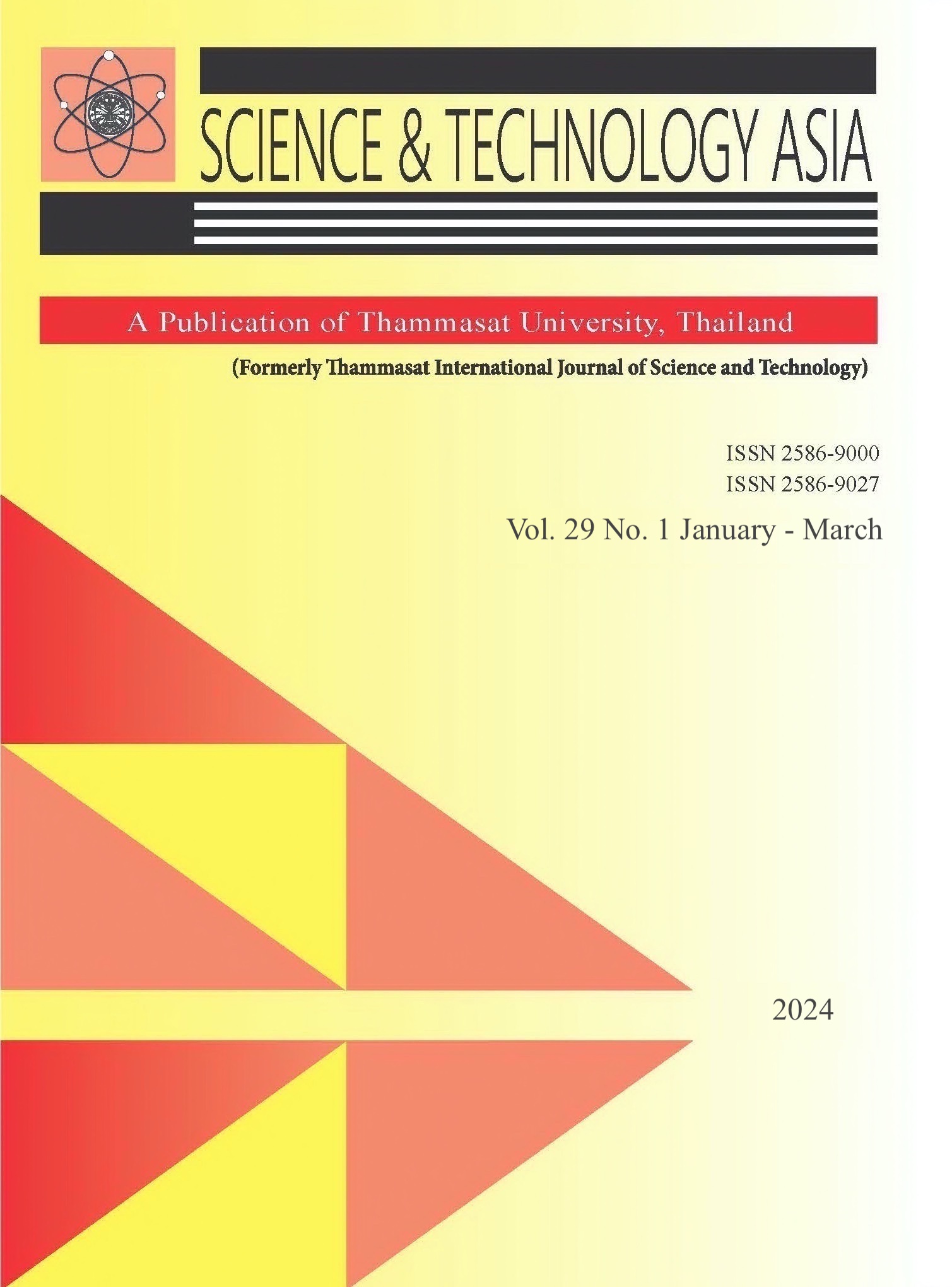Effect Analysis of Pollutant Distribution on the Flashover Performance of Porcelain and Composite insulator using Finite Element Method
Main Article Content
Abstract
The paper presents the investigation of flashover performance on porcelain and composite insulators by using the finite element-based method. The main focus of this study was to investigate the performance of insulators when operated under pollution since pollution is the leading factor of flashover phenomenon. In terms of the pollution configuration, different methodologies were proposed according to the nature of the insulating material. For porcelain insulators, the assumption based on previous research is that pollution accumulates as a conductive layer covering the surface of the insulator. In contrast, the composite insulator will have particulate matter to indicate the formation of a pollution layer on the insulator surface as the hydrophobic property would provide additional resistance to contamination. The simulation was conducted in finite element-based method software by applying different types of pollution configurations to porcelain and composite insulator surfaces. Evaluation of the simulation results will be based on the evaluation of electric field strength across the insulators surfaces. By comparing the electric field profiles across the insulator’s surfaces, the flashover performances of the insulators can be determined. Based on the evaluation results, the composite insulator shows better performance under pollution conditions, providing a more stable operation and stands as a more economical replacement for porcelain insulators to ensure the sustainability and reliability of the power system.
Article Details

This work is licensed under a Creative Commons Attribution-NonCommercial-NoDerivatives 4.0 International License.
References
F. A Jamaludin, M. Z. A. Ab Kadir, M.Izadi, N. Azis, J. Jasni, M. S. Rahman (2017) “Effects of RTV coating on the electrical performance of polymer insulator under lightning impulse voltage condition” PloS one, vol. 12, https://doi.org/10.1371/journal.pone.0187892
Z.Mohd Nawi, N.R. Misbah and M.Z.A. Ab Kadir (2010) "A Critical Review on the Contamination Effect on Distribution Overhead Lines," International Review of Electrical Engineering (I.R.E.E), Vol. 5, No.5 Pp.2461-2470
Sanyal, S., Aslam, F., Kim, T. et al. Deterioration of Porcelain Insulators Utilized in Overhead Transmission Lines: A Review. Trans. Electr. Electron. Mater. 21, 16–21 (2020). https://doi.org/10.1007/s42341-019-00143-5
Saleem, Muhammad Zaheer, and Mohammad Akbar. 2022. "Review of the Performance of High-Voltage Composite Insulators" Polymers 14, no. 3: 431. https://doi.org/10.3390/polym14030431
Ogbonna, Victor E., Patricia I. Popoola, Olawale M. Popoola, and Samson O. Adeosun. "A comparative study on the failure analysis of field failed high voltage composite insulator core rods and recommendation of composite insulators: A review." Engineering Failure Analysis 138 (2022): 106369. https://doi.org/10.1016/j.engfailanal.2022.106369
Xingliang Jiang, et al. “Comparison of DC Pollution Flashover Performances of Various Types of Porcelain, Glass, and Composite Insulators.” IEEE Transactions on Power Delivery, vol. 23, no. 2, Apr. 2008, pp. 1183–90. DOI.org (Crossref), DOI: 10.1109/TPWRD.2007.908779
Farzaneh, M., et al. “Effect of Insulator Diameter on AC Flashover Voltage of an Ice-Covered Insulator String.” IEEE Transactions on Dielectrics and Electrical Insulation, vol. 13, no. 2, Apr. 2006, pp. 264–71. DOI.org (Crossref), 10.1109/TDEI.2006.1624271.
Jabbari, M., et al. “Application of a New Dynamic Numerical Model to Predict Polluted Insulator Flashover Voltage.” 2014 IEEE Electrical Insulation Conference (EIC), IEEE, 2014, pp. 102–06. DOI.org (Crossref), https://doi.org/10.1109/EIC.2014.6869356.
Banik, A., Mukherjee, A. & Dalai, S. Development of a pollution flashover model for 11 kV porcelain and silicon rubber insulator by using COMSOL multiphysics. Electr Eng 100, 533–541 (2018). https://doi.org/10.1007/s00202-017-0520-8
Ming, Lei, et al. “Simulation Analysis of Flashover Characteristics of 220kV Composite Insulators Based on Finite-Element Method.” 2009 IEEE 9th International Conference on the Properties and Applications of Dielectric Materials, 2009, pp. 697–700. IEEE Xplore, https://doi.org/10.1109/ICPADM.2009.5252335.
P. S. Gohsh, S. Chakvravorti and N. Chatterjee, "Estimation of Time to Flashover Characteristics of Contaminated Electrolytic Surfaces using a Neural Network", IEEE Trans. on Dielectrics and Electrical Insulation, Vol. 2, N° 6, pp. 1064-1074, 1995.
Metwally, Ibrahim A.; Abdus Salam, Md; Al-Maqrashi, Ali; Sumry, Saif AR; and Al-Harthy, Saif SH (2006) "Electrostatic and Electrodynamic Field Analyses of 33kV Line Insulators," International Journal of Emerging Electric Power Systems: Vol. 7: Iss. 3, Article 3. DOI: 10.2202/1553-779X.1330
Aravind, K. A., et al. “Flashover Performance of Composite and Porcelain Insulators.” 2019 International Conference on High Voltage Engineering and Technology (ICHVET), IEEE, 2019, pp. 1–3. DOI.org (Crossref), https://doi.org/10.1109/ICHVET.2019.8724328.
F. Obenaus, Fremdschicht, “Uberschlag und Kriechweglange”, Deutsche Electrotechnik, pp. 135–136, 1958.
Aziz, Esraa, Fatiha Aouabed, Hossam Abdellah, and Adrienn Dineva. "Case Study: Optimizing Grading Ring Design for High Voltage Polymeric Insulators in Power Transmission Systems for Enhanced Electric Field and Voltage Distribution by Using a Finite Element Method." Energies 16, no. 13 (2023): 5235. https://doi.org/10.3390/en16135235
S. D. Pawar; P. Murugavel; D. M. Lal (2009). "Effect of relative humidity and sea level pressure on electrical conductivity of air over Indian Ocean". Journal of Geophysical Research. 114 (D2): D02205. Bibcode:2009JGRD..114.2205P. doi:10.1029/2007JD009716.
E. Seran; M. Godefroy; E. Pili (2016). "What we can learn from measurements of air electric conductivity in 222Rn ‐ rich atmosphere". Earth and Space Science. 4 (2): 91–106. Bibcode:2017E&SS....4...91S. doi:10.1002/2016EA000241.
Chaudhuri, S. P., et al. “Electrical Resistivity of Porcelain in Relation to Constitution.” Ceramics International, vol. 25, no. 1, Jan. 1999, pp. 91–99. DOI.org (Crossref), https://doi.org/10.1016/S0272-8842(98)00006-6.
Golnabi, H. & Matloob, M & Bahar, Mahmood & Sharifian, Mozhgan. (2009). Investigation of electrical conductivity of different water liquids and electrolyte solutions. Iranian Physical Journal. 3.
Namitha, L. K., and M. T. Sebastian. “Microwave Dielectric Properties of Flexible Silicone Rubber – Ba(Zn1/3Ta2/3)O3 Composite Substrates.” Materials Research Bulletin, vol. 48, no. 11, Nov. 2013, pp. 4911–16. DOI.org (Crossref), https://doi.org/10.1016/j.materresbull.2013.07.029.


